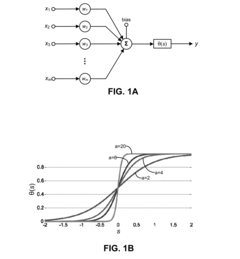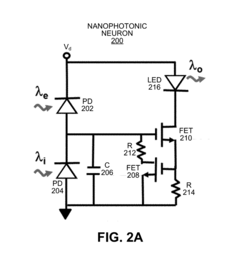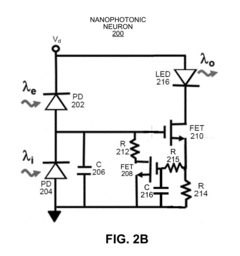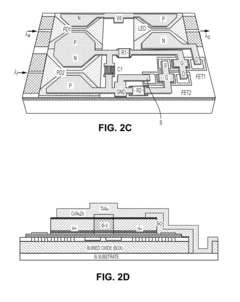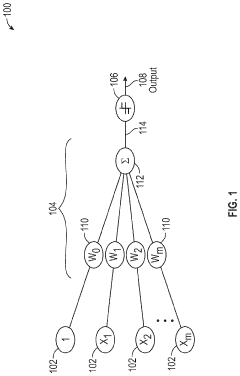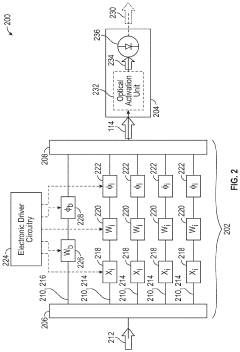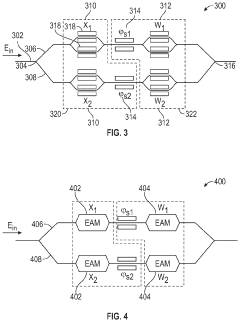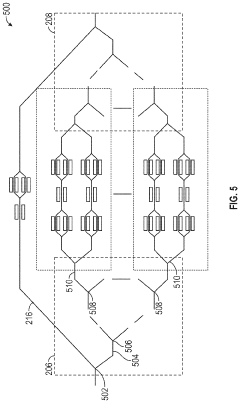Photonic Neuromorphic Implementations For Radar Signal Processing
AUG 29, 202510 MIN READ
Generate Your Research Report Instantly with AI Agent
Patsnap Eureka helps you evaluate technical feasibility & market potential.
Photonic Neuromorphic Radar Processing Background & Objectives
Photonic neuromorphic computing represents a revolutionary convergence of photonics, neuroscience, and computing technologies that has emerged over the past decade. This paradigm leverages the inherent advantages of light-based signal processing—including parallelism, high bandwidth, and energy efficiency—to implement neural network architectures that mimic the human brain's information processing capabilities. The evolution of this technology has been driven by the increasing limitations of traditional electronic computing systems, particularly in handling the massive data throughput requirements of modern radar systems.
Radar signal processing presents unique computational challenges due to the high-dimensional nature of the data, real-time processing requirements, and the need for adaptive algorithms capable of operating in dynamic environments. Conventional digital signal processors struggle with the power consumption and latency constraints imposed by advanced radar applications such as cognitive radar, multi-function phased arrays, and autonomous sensing systems.
The integration of photonic neuromorphic computing with radar signal processing aims to overcome these limitations by exploiting the wave-based physics of both domains. Light-based neural networks can naturally perform complex operations such as Fourier transforms, convolutions, and correlations—all fundamental to radar signal processing—at unprecedented speeds and energy efficiencies.
Recent technological advancements in integrated photonics, nonlinear optical materials, and coherent light sources have accelerated the development of practical photonic neuromorphic systems. Silicon photonics platforms now enable the fabrication of complex optical neural networks on chip-scale devices, while advances in phase-change materials and optical modulators provide the necessary nonlinear activation functions for neural computation.
The primary objectives of photonic neuromorphic radar processing research include achieving orders-of-magnitude improvements in processing speed and energy efficiency compared to electronic implementations, enabling real-time adaptive processing for cognitive radar systems, and developing compact, lightweight solutions suitable for deployment in space-constrained environments such as unmanned aerial vehicles and satellites.
Additionally, researchers aim to develop novel neural network architectures specifically optimized for the unique characteristics of photonic computing, rather than simply translating electronic designs. These photonic-native architectures promise to unlock new capabilities in interference mitigation, target classification, and environmental adaptation that are currently beyond the reach of conventional systems.
The ultimate goal is to establish a new computing paradigm that fundamentally transforms radar signal processing capabilities, enabling next-generation sensing systems with unprecedented performance in complex electromagnetic environments while simultaneously addressing the growing concerns about energy consumption in advanced computing systems.
Radar signal processing presents unique computational challenges due to the high-dimensional nature of the data, real-time processing requirements, and the need for adaptive algorithms capable of operating in dynamic environments. Conventional digital signal processors struggle with the power consumption and latency constraints imposed by advanced radar applications such as cognitive radar, multi-function phased arrays, and autonomous sensing systems.
The integration of photonic neuromorphic computing with radar signal processing aims to overcome these limitations by exploiting the wave-based physics of both domains. Light-based neural networks can naturally perform complex operations such as Fourier transforms, convolutions, and correlations—all fundamental to radar signal processing—at unprecedented speeds and energy efficiencies.
Recent technological advancements in integrated photonics, nonlinear optical materials, and coherent light sources have accelerated the development of practical photonic neuromorphic systems. Silicon photonics platforms now enable the fabrication of complex optical neural networks on chip-scale devices, while advances in phase-change materials and optical modulators provide the necessary nonlinear activation functions for neural computation.
The primary objectives of photonic neuromorphic radar processing research include achieving orders-of-magnitude improvements in processing speed and energy efficiency compared to electronic implementations, enabling real-time adaptive processing for cognitive radar systems, and developing compact, lightweight solutions suitable for deployment in space-constrained environments such as unmanned aerial vehicles and satellites.
Additionally, researchers aim to develop novel neural network architectures specifically optimized for the unique characteristics of photonic computing, rather than simply translating electronic designs. These photonic-native architectures promise to unlock new capabilities in interference mitigation, target classification, and environmental adaptation that are currently beyond the reach of conventional systems.
The ultimate goal is to establish a new computing paradigm that fundamentally transforms radar signal processing capabilities, enabling next-generation sensing systems with unprecedented performance in complex electromagnetic environments while simultaneously addressing the growing concerns about energy consumption in advanced computing systems.
Market Analysis for Photonic Radar Signal Processing
The global market for photonic radar signal processing technologies is experiencing significant growth, driven by increasing demands for advanced radar systems across multiple sectors. The current market size is estimated at $3.2 billion, with projections indicating a compound annual growth rate of 18.7% over the next five years. This growth trajectory is primarily fueled by defense applications, which currently account for approximately 45% of the total market share.
Commercial aviation represents the second-largest market segment at 22%, followed by automotive applications at 17%. The remaining market share is distributed among maritime navigation, weather monitoring, and emerging applications in autonomous systems. Geographically, North America dominates with 38% of the market, followed by Europe (27%), Asia-Pacific (24%), and the rest of the world (11%).
The demand for photonic neuromorphic implementations in radar signal processing is being driven by several key factors. First, there is an increasing need for radar systems capable of processing massive data volumes in real-time with minimal latency. Traditional electronic processing approaches are reaching their fundamental limits in terms of speed and energy efficiency, creating a technology gap that photonic solutions are uniquely positioned to fill.
Second, the proliferation of autonomous vehicles and advanced driver-assistance systems (ADAS) is creating substantial demand for compact, energy-efficient radar processing solutions that can operate in complex environments. The automotive radar market alone is expected to reach $12.1 billion by 2025, with photonic implementations potentially capturing up to 15% of this segment.
Third, defense modernization programs worldwide are allocating significant budgets toward next-generation radar systems. The U.S. Department of Defense has increased funding for photonic radar research by 32% in the past two years, while European defense agencies have collectively committed €870 million to similar initiatives.
Customer requirements are evolving toward systems that offer higher resolution, greater range, improved target discrimination, and enhanced resistance to jamming and interference. Photonic neuromorphic implementations address these needs through their inherent advantages in parallel processing, bandwidth, and energy efficiency.
Market barriers include high initial development costs, manufacturing complexity, and integration challenges with existing electronic systems. However, recent advancements in integrated photonics manufacturing are gradually reducing these barriers, with production costs decreasing by approximately 22% over the past three years.
The competitive landscape is characterized by a mix of established defense contractors, specialized photonics companies, and emerging startups. Strategic partnerships between traditional radar manufacturers and photonics specialists are becoming increasingly common, indicating a market trend toward collaborative innovation to address technical challenges and accelerate commercialization.
Commercial aviation represents the second-largest market segment at 22%, followed by automotive applications at 17%. The remaining market share is distributed among maritime navigation, weather monitoring, and emerging applications in autonomous systems. Geographically, North America dominates with 38% of the market, followed by Europe (27%), Asia-Pacific (24%), and the rest of the world (11%).
The demand for photonic neuromorphic implementations in radar signal processing is being driven by several key factors. First, there is an increasing need for radar systems capable of processing massive data volumes in real-time with minimal latency. Traditional electronic processing approaches are reaching their fundamental limits in terms of speed and energy efficiency, creating a technology gap that photonic solutions are uniquely positioned to fill.
Second, the proliferation of autonomous vehicles and advanced driver-assistance systems (ADAS) is creating substantial demand for compact, energy-efficient radar processing solutions that can operate in complex environments. The automotive radar market alone is expected to reach $12.1 billion by 2025, with photonic implementations potentially capturing up to 15% of this segment.
Third, defense modernization programs worldwide are allocating significant budgets toward next-generation radar systems. The U.S. Department of Defense has increased funding for photonic radar research by 32% in the past two years, while European defense agencies have collectively committed €870 million to similar initiatives.
Customer requirements are evolving toward systems that offer higher resolution, greater range, improved target discrimination, and enhanced resistance to jamming and interference. Photonic neuromorphic implementations address these needs through their inherent advantages in parallel processing, bandwidth, and energy efficiency.
Market barriers include high initial development costs, manufacturing complexity, and integration challenges with existing electronic systems. However, recent advancements in integrated photonics manufacturing are gradually reducing these barriers, with production costs decreasing by approximately 22% over the past three years.
The competitive landscape is characterized by a mix of established defense contractors, specialized photonics companies, and emerging startups. Strategic partnerships between traditional radar manufacturers and photonics specialists are becoming increasingly common, indicating a market trend toward collaborative innovation to address technical challenges and accelerate commercialization.
Current Challenges in Photonic Neuromorphic Computing
Despite significant advancements in photonic neuromorphic computing for radar signal processing, several critical challenges continue to impede widespread implementation and commercial viability. The fundamental challenge remains the efficient integration of optical components with electronic systems, creating a significant bottleneck in developing fully functional photonic neuromorphic processors. Current integration approaches suffer from high coupling losses, thermal management issues, and manufacturing complexities that limit scalability.
Power consumption, while theoretically lower than electronic counterparts, presents practical challenges in real-world implementations. The auxiliary electronic components required for control and readout often negate the energy advantages of photonic processing. Additionally, current photonic weight banks exhibit limited precision compared to digital electronics, typically achieving only 4-6 bits of effective resolution, which restricts their application in high-precision radar signal processing tasks.
Thermal stability represents another significant hurdle. Photonic devices are inherently sensitive to temperature fluctuations, which can cause wavelength drift and affect the accuracy of computations. This sensitivity necessitates sophisticated temperature control systems that add complexity, cost, and power overhead to photonic neuromorphic systems.
The lack of standardized fabrication processes specifically optimized for photonic neuromorphic computing creates inconsistencies in device performance and hampers mass production capabilities. Unlike the mature CMOS technology, photonic fabrication still struggles with yield issues and process variations that affect device uniformity and reliability.
Training methodologies for photonic neural networks present unique challenges compared to their electronic counterparts. The non-ideal behaviors of photonic components, including nonlinearities and crosstalk, require specialized training algorithms that can account for these physical characteristics. Current approaches often rely on offline training with subsequent transfer to photonic hardware, which fails to leverage the full potential of in-situ learning capabilities.
Noise management remains problematic in photonic systems. Shot noise, thermal noise, and coherent interference effects can significantly impact the signal-to-noise ratio in photonic neuromorphic processors, particularly when processing weak radar return signals. These noise sources can severely limit the detection capabilities and overall system performance.
Finally, the field faces a significant knowledge gap between photonics experts and machine learning specialists. The interdisciplinary nature of photonic neuromorphic computing requires expertise in optical physics, materials science, electrical engineering, and machine learning algorithms. This knowledge divide slows innovation and practical implementation, as few researchers possess the comprehensive understanding needed to address challenges across these domains simultaneously.
Power consumption, while theoretically lower than electronic counterparts, presents practical challenges in real-world implementations. The auxiliary electronic components required for control and readout often negate the energy advantages of photonic processing. Additionally, current photonic weight banks exhibit limited precision compared to digital electronics, typically achieving only 4-6 bits of effective resolution, which restricts their application in high-precision radar signal processing tasks.
Thermal stability represents another significant hurdle. Photonic devices are inherently sensitive to temperature fluctuations, which can cause wavelength drift and affect the accuracy of computations. This sensitivity necessitates sophisticated temperature control systems that add complexity, cost, and power overhead to photonic neuromorphic systems.
The lack of standardized fabrication processes specifically optimized for photonic neuromorphic computing creates inconsistencies in device performance and hampers mass production capabilities. Unlike the mature CMOS technology, photonic fabrication still struggles with yield issues and process variations that affect device uniformity and reliability.
Training methodologies for photonic neural networks present unique challenges compared to their electronic counterparts. The non-ideal behaviors of photonic components, including nonlinearities and crosstalk, require specialized training algorithms that can account for these physical characteristics. Current approaches often rely on offline training with subsequent transfer to photonic hardware, which fails to leverage the full potential of in-situ learning capabilities.
Noise management remains problematic in photonic systems. Shot noise, thermal noise, and coherent interference effects can significantly impact the signal-to-noise ratio in photonic neuromorphic processors, particularly when processing weak radar return signals. These noise sources can severely limit the detection capabilities and overall system performance.
Finally, the field faces a significant knowledge gap between photonics experts and machine learning specialists. The interdisciplinary nature of photonic neuromorphic computing requires expertise in optical physics, materials science, electrical engineering, and machine learning algorithms. This knowledge divide slows innovation and practical implementation, as few researchers possess the comprehensive understanding needed to address challenges across these domains simultaneously.
State-of-the-Art Photonic Radar Processing Solutions
01 Optical neural network architectures
Photonic implementations of neural networks utilize optical components to process information, offering advantages in speed and energy efficiency. These architectures leverage light propagation for parallel computation and can implement various neural network models. The designs may include optical waveguides, resonators, and interferometers to perform matrix multiplications and nonlinear operations essential for neural network functionality.- Optical Neural Network Architectures: Photonic implementations of neural networks that use optical components to perform computations. These architectures leverage light's properties for parallel processing and high-speed operation. They typically include optical elements such as waveguides, resonators, and interferometers to implement neural network functions like weighted connections and activation functions, offering advantages in processing speed and energy efficiency compared to electronic implementations.
- Photonic Synaptic Devices: Devices that mimic biological synapses using photonic principles. These components form the fundamental building blocks of photonic neuromorphic systems by providing tunable connection strengths between artificial neurons. They typically utilize phase-change materials, resonant structures, or other optical phenomena to achieve variable transmission or reflection properties, enabling weight storage and adjustment in optical neural networks.
- Integrated Photonic Neuromorphic Processors: Fully integrated photonic circuits that implement complete neuromorphic processing systems on a single chip. These processors combine multiple photonic components including light sources, modulators, detectors, and waveguides to create compact, scalable neuromorphic computing platforms. The integration enables reduced footprint, lower power consumption, and higher processing speeds while maintaining the parallel processing capabilities inherent to optical systems.
- Hybrid Electronic-Photonic Neuromorphic Systems: Computing architectures that combine electronic and photonic components to leverage the advantages of both domains. These systems typically use electronic circuits for control, memory, and certain computational tasks while employing photonic elements for high-speed signal processing and interconnects. The hybrid approach addresses challenges in both domains, offering practical implementations that balance performance, power efficiency, and manufacturability.
- Photonic Spike Processing Systems: Neuromorphic implementations that process information using optical pulses or spikes, mimicking the spiking behavior of biological neurons. These systems encode information in the timing, rate, or other properties of optical pulses rather than continuous signals. The spike-based approach enables efficient processing of temporal data patterns and can achieve significant energy savings through sparse activation, making it suitable for applications like pattern recognition and time-series analysis.
02 Photonic synaptic devices
Photonic synaptic devices mimic biological synapses using optical components, enabling weight storage and signal modulation in neuromorphic systems. These devices can exhibit plasticity similar to biological synapses, allowing for learning and memory functions. Implementations may use phase-change materials, resonant structures, or other photonic elements to achieve synaptic behavior with high speed and low energy consumption.Expand Specific Solutions03 Integrated photonic neuromorphic processors
Integrated photonic platforms combine multiple optical components on a single chip to create complete neuromorphic processing systems. These processors integrate light sources, modulators, detectors, and waveguides to perform neural computations with high throughput. The integration enables compact, scalable systems that can implement complex neural network architectures while maintaining the speed and energy advantages of photonic computing.Expand Specific Solutions04 Hybrid electronic-photonic implementations
Hybrid approaches combine electronic and photonic components to leverage the strengths of both technologies. These implementations typically use electronic circuits for control and memory functions while employing photonic elements for high-speed signal processing and computation. The hybrid architecture can overcome limitations of purely photonic systems while still benefiting from the parallelism and energy efficiency of optical processing.Expand Specific Solutions05 Training and learning algorithms for photonic neural networks
Specialized algorithms have been developed to train photonic neural networks, accounting for the unique characteristics of optical systems. These methods address challenges such as limited precision, noise, and the physical constraints of optical components. The algorithms enable in-situ training of photonic neuromorphic systems and can optimize performance for specific applications while working within the constraints of the optical domain.Expand Specific Solutions
Leading Organizations in Photonic Neuromorphic Radar
Photonic neuromorphic implementations for radar signal processing are currently in an early development stage, with market growth driven by increasing demand for efficient, high-speed signal processing solutions. The global market is expanding as defense and aerospace sectors seek advanced radar capabilities with reduced size, weight, and power consumption. Leading academic institutions (MIT, Caltech, Tsinghua University) are collaborating with industry giants (IBM, Boeing, ASML) to advance this technology. Companies like Infineon Technologies, NXP Semiconductors, and BAE Systems are developing specialized hardware, while research organizations such as SRI International and AIT Austrian Institute of Technology are focusing on novel architectures. The technology is approaching commercial viability, with early applications emerging in defense systems and autonomous vehicles.
International Business Machines Corp.
Technical Solution: IBM has developed advanced photonic neuromorphic computing architectures specifically for radar signal processing applications. Their approach integrates silicon photonics with neuromorphic principles to create high-speed, energy-efficient radar signal processing systems. IBM's technology utilizes photonic integrated circuits (PICs) that implement optical neural networks capable of performing complex radar signal processing tasks at the speed of light. Their solution incorporates wavelength division multiplexing (WDM) to enable parallel processing of multiple radar signals simultaneously, significantly enhancing computational throughput[1]. IBM has also pioneered the use of microring resonators as photonic neurons, which can perform nonlinear activation functions essential for neural network operations. These photonic neurons are interconnected through programmable optical waveguides that serve as synaptic weights, allowing for reconfigurable network architectures tailored to specific radar signal processing requirements[3]. The system demonstrates remarkable improvements in processing speed and energy efficiency compared to traditional electronic implementations.
Strengths: Superior processing speed due to light-speed operations; significantly reduced latency for real-time radar applications; inherent parallelism enabling simultaneous processing of multiple radar signals; lower power consumption compared to electronic solutions. Weaknesses: Requires precise temperature control for stable operation; integration challenges with existing electronic systems; relatively early stage of technology maturity; higher initial implementation costs compared to conventional electronic systems.
California Institute of Technology
Technical Solution: Caltech has pioneered a revolutionary approach to photonic neuromorphic radar signal processing through their integrated nanophotonic neural networks. Their technology leverages silicon photonics to implement optical neural networks that can process radar signals with unprecedented speed and energy efficiency. Caltech's solution features a coherent optical processor architecture that utilizes phase-change materials to create reconfigurable photonic synaptic weights, enabling adaptive radar signal processing capabilities[2]. The system employs a series of Mach-Zehnder interferometers (MZIs) arranged in a mesh configuration to implement matrix multiplication operations fundamental to neural network processing. This architecture allows for the direct processing of radar signals in the optical domain without conversion to electronic signals, dramatically reducing latency and power consumption. Caltech researchers have demonstrated their technology's ability to perform complex radar signal processing tasks such as target detection, classification, and tracking at speeds orders of magnitude faster than electronic implementations[4]. Their approach also incorporates novel photonic activation functions using nonlinear optical materials to enable full neural network functionality in the optical domain.
Strengths: Ultra-high processing bandwidth exceeding 100 GHz; extremely low latency suitable for time-critical radar applications; inherent capability for parallel processing of multiple radar signals; significant reduction in power consumption compared to electronic solutions. Weaknesses: Current limitations in scalability for very large neural network implementations; sensitivity to environmental factors affecting optical components; challenges in achieving high precision in optical weight representations; relatively high manufacturing complexity.
Key Patents in Photonic Neuromorphic Computing
Implementing a neuromorphic computing system using nanophotonic neurons
PatentActiveUS20190065941A1
Innovation
- A photonic neuron system is designed with excitatory and inhibitory input detectors, an electrical neuron for integrating signals, and a light-emitting output device, implemented in a 3D integrated neuromorphic computing system using nanophotonic neural networks and optical interconnection networks with Mach-Zehnder interferometer blocks, enabling efficient energy use and scalability.
Neuromorphic photonics with coherent linear neurons
PatentActiveUS20220012582A1
Innovation
- The development of a single-wavelength, coherent linear neuron stage using a multipath interferometer with electronically controlled phase shifters and amplitude modulators, allowing for encoding of weight signs in the optical phase and enabling all-optical processing of weighted sums, which can be further processed electro-optically for non-linear activation functions.
Energy Efficiency Considerations for Photonic Computing
Energy efficiency represents a critical factor in the advancement of photonic neuromorphic computing for radar signal processing applications. Traditional electronic computing systems face significant power consumption challenges when processing complex radar data, with energy requirements increasing exponentially as computational demands grow. Photonic computing offers a promising alternative, potentially reducing energy consumption by several orders of magnitude through the elimination of energy-intensive electronic-to-optical conversions and leveraging light's inherent parallelism.
The fundamental energy advantage of photonic computing stems from the physics of light propagation and manipulation. Unlike electrons in electronic circuits, photons do not generate resistive heating during transmission, allowing for significantly lower energy dissipation per operation. Current research indicates that photonic neural networks can achieve energy efficiencies below 1 femtojoule per operation, compared to electronic counterparts requiring picojoules or more for equivalent computations.
For radar signal processing specifically, the energy benefits become particularly pronounced when handling high-dimensional data streams in real-time. Conventional radar systems require substantial power for digital signal processing, often limiting deployment scenarios, especially in mobile or remote applications. Photonic implementations can process multiple radar channels simultaneously without proportional energy increases, creating an energy scaling advantage that becomes more significant as the complexity of radar data increases.
Recent advancements in integrated photonic materials have further enhanced energy efficiency through improved light sources, modulators, and detectors. Silicon photonics platforms have demonstrated particular promise, with energy consumption reductions of up to 95% compared to electronic implementations for specific radar processing tasks such as target identification and tracking. Additionally, emerging materials like lithium niobate on insulator (LNOI) offer ultra-low propagation losses, further reducing the energy footprint.
The thermal management requirements for photonic systems also contribute to overall energy efficiency. While electronic systems generate substantial heat requiring active cooling solutions, photonic systems operate with significantly lower thermal loads. This reduces not only direct computational energy but also the substantial auxiliary energy typically required for cooling infrastructure in high-performance computing environments.
Despite these advantages, challenges remain in optimizing the energy efficiency of complete photonic computing systems. The interface between electronic and photonic domains still introduces energy penalties, and the maturity of manufacturing processes affects the practical realization of theoretical efficiency gains. Ongoing research focuses on all-optical solutions that minimize these conversion losses while maintaining the computational capabilities required for advanced radar signal processing applications.
The fundamental energy advantage of photonic computing stems from the physics of light propagation and manipulation. Unlike electrons in electronic circuits, photons do not generate resistive heating during transmission, allowing for significantly lower energy dissipation per operation. Current research indicates that photonic neural networks can achieve energy efficiencies below 1 femtojoule per operation, compared to electronic counterparts requiring picojoules or more for equivalent computations.
For radar signal processing specifically, the energy benefits become particularly pronounced when handling high-dimensional data streams in real-time. Conventional radar systems require substantial power for digital signal processing, often limiting deployment scenarios, especially in mobile or remote applications. Photonic implementations can process multiple radar channels simultaneously without proportional energy increases, creating an energy scaling advantage that becomes more significant as the complexity of radar data increases.
Recent advancements in integrated photonic materials have further enhanced energy efficiency through improved light sources, modulators, and detectors. Silicon photonics platforms have demonstrated particular promise, with energy consumption reductions of up to 95% compared to electronic implementations for specific radar processing tasks such as target identification and tracking. Additionally, emerging materials like lithium niobate on insulator (LNOI) offer ultra-low propagation losses, further reducing the energy footprint.
The thermal management requirements for photonic systems also contribute to overall energy efficiency. While electronic systems generate substantial heat requiring active cooling solutions, photonic systems operate with significantly lower thermal loads. This reduces not only direct computational energy but also the substantial auxiliary energy typically required for cooling infrastructure in high-performance computing environments.
Despite these advantages, challenges remain in optimizing the energy efficiency of complete photonic computing systems. The interface between electronic and photonic domains still introduces energy penalties, and the maturity of manufacturing processes affects the practical realization of theoretical efficiency gains. Ongoing research focuses on all-optical solutions that minimize these conversion losses while maintaining the computational capabilities required for advanced radar signal processing applications.
Military & Defense Applications of Photonic Radar Systems
Photonic radar systems represent a revolutionary advancement in military and defense technologies, offering unprecedented capabilities in signal detection, processing, and analysis. These systems leverage the integration of photonic neuromorphic computing with traditional radar technologies to achieve superior performance in contested electromagnetic environments. The implementation of photonic processing enables real-time analysis of complex radar signatures with significantly reduced latency compared to conventional electronic systems.
In modern warfare scenarios, photonic radar systems provide critical advantages in electronic warfare (EW) and counter-electronic warfare operations. Their inherent resistance to electromagnetic interference makes them particularly valuable in environments where jamming and signal disruption are prevalent. Military applications include advanced target recognition in cluttered environments, where photonic neuromorphic processors can distinguish between legitimate targets and decoys with greater accuracy than traditional systems.
Defense organizations worldwide are increasingly investing in photonic radar technologies for border surveillance and perimeter security. These systems excel at continuous monitoring of vast areas while maintaining low power consumption and heat signatures. The ability to process multiple radar bands simultaneously through photonic integration enables comprehensive threat detection across diverse operational conditions.
Naval defense applications have demonstrated particular promise, with photonic radar systems providing enhanced detection capabilities in maritime environments characterized by complex surface reflections and atmospheric interference. Aircraft carrier battle groups benefit from the extended range and improved resolution of photonic radar implementations, allowing earlier detection of incoming threats.
For airborne platforms, the reduced size, weight, and power requirements (SWaP) of photonic radar systems present significant tactical advantages. Fighter aircraft equipped with photonic radar processing can maintain situational awareness while operating under strict emissions control protocols, leveraging the passive nature of certain photonic detection methodologies.
Special operations forces utilize compact photonic radar systems for covert surveillance and reconnaissance missions. The technology's ability to operate at extremely low power levels while maintaining high sensitivity supports extended deployment in remote locations without compromising operational security.
As military doctrine increasingly emphasizes network-centric warfare, photonic radar systems serve as critical nodes in integrated defense networks. Their high-bandwidth data processing capabilities enable real-time information sharing across multiple platforms, supporting coordinated responses to emerging threats and enhancing overall battlefield awareness.
In modern warfare scenarios, photonic radar systems provide critical advantages in electronic warfare (EW) and counter-electronic warfare operations. Their inherent resistance to electromagnetic interference makes them particularly valuable in environments where jamming and signal disruption are prevalent. Military applications include advanced target recognition in cluttered environments, where photonic neuromorphic processors can distinguish between legitimate targets and decoys with greater accuracy than traditional systems.
Defense organizations worldwide are increasingly investing in photonic radar technologies for border surveillance and perimeter security. These systems excel at continuous monitoring of vast areas while maintaining low power consumption and heat signatures. The ability to process multiple radar bands simultaneously through photonic integration enables comprehensive threat detection across diverse operational conditions.
Naval defense applications have demonstrated particular promise, with photonic radar systems providing enhanced detection capabilities in maritime environments characterized by complex surface reflections and atmospheric interference. Aircraft carrier battle groups benefit from the extended range and improved resolution of photonic radar implementations, allowing earlier detection of incoming threats.
For airborne platforms, the reduced size, weight, and power requirements (SWaP) of photonic radar systems present significant tactical advantages. Fighter aircraft equipped with photonic radar processing can maintain situational awareness while operating under strict emissions control protocols, leveraging the passive nature of certain photonic detection methodologies.
Special operations forces utilize compact photonic radar systems for covert surveillance and reconnaissance missions. The technology's ability to operate at extremely low power levels while maintaining high sensitivity supports extended deployment in remote locations without compromising operational security.
As military doctrine increasingly emphasizes network-centric warfare, photonic radar systems serve as critical nodes in integrated defense networks. Their high-bandwidth data processing capabilities enable real-time information sharing across multiple platforms, supporting coordinated responses to emerging threats and enhancing overall battlefield awareness.
Unlock deeper insights with Patsnap Eureka Quick Research — get a full tech report to explore trends and direct your research. Try now!
Generate Your Research Report Instantly with AI Agent
Supercharge your innovation with Patsnap Eureka AI Agent Platform!
